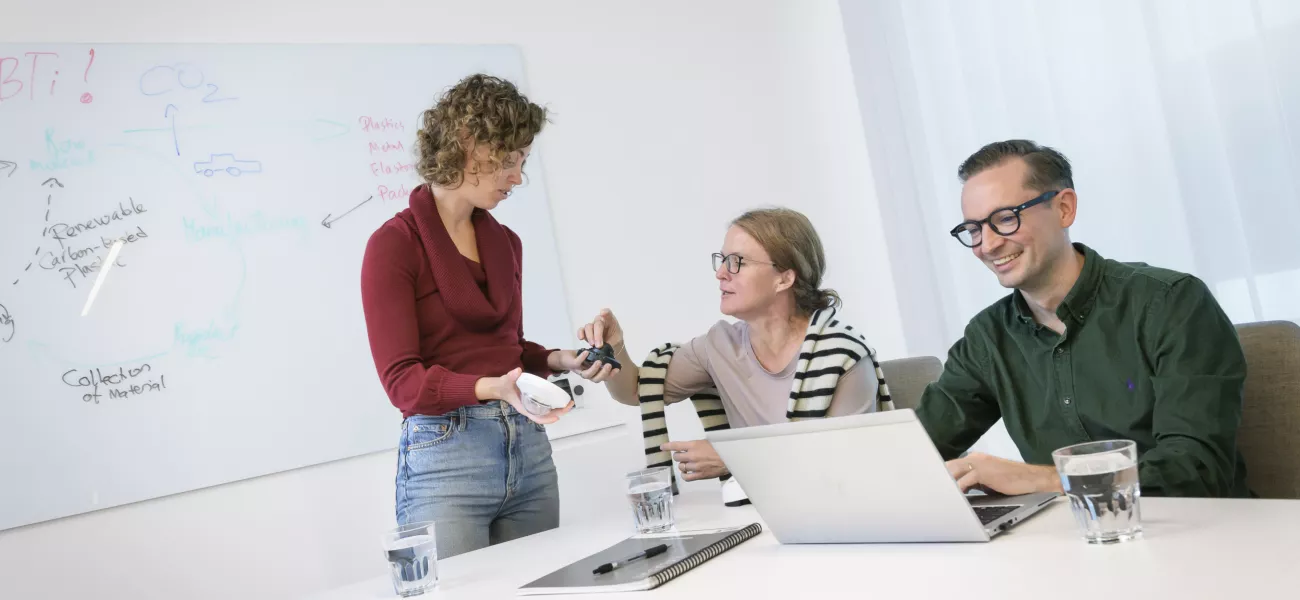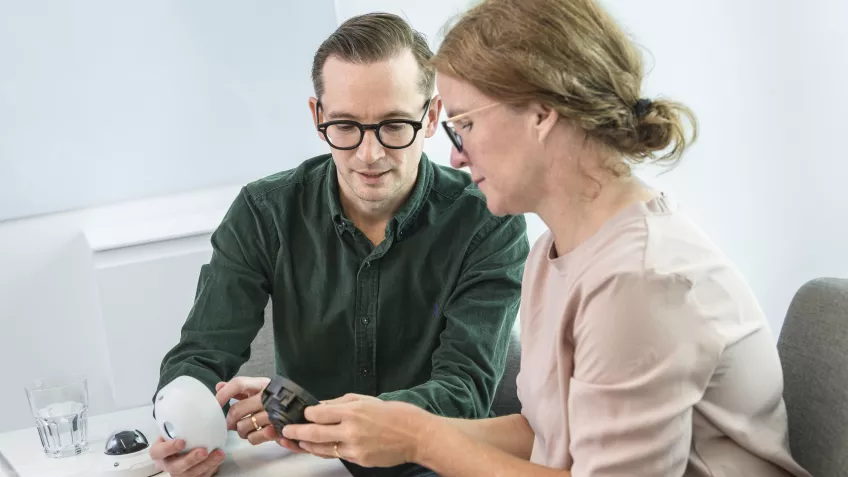
いわゆるエコイノベーションは、メーカーが持続可能性に関する顧客の要求を実現するために不可欠なものとなっています。顧客の意識の高まりとともに、非政府組織(NGO)からの圧力、新たな法的枠組みの導入、メーカーにより厳しいガイドラインを提唱する業界主催のイニシアチブが、大きな変化を促しています。
国連のSustainable Development Goals (SDGs)もその一翼を担っており、地球を守り、あらゆる場所で全ての人の生活と将来性を向上させるための行動を世界的に呼びかけています。多くの組織が、事業をより持続可能なものにするための積極的な取り組みを行うことで、SDGsを支援しています。
Axisでは、私たちの選択が私たちの未来を決定することを認識し、人と環境のために良い選択をすることに焦点を当てています。私たちは、進歩とは技術革新以上のものであることを知っており、バリューチェーン全体を通じて環境への影響を最小限に抑えるよう努力しています。
私たちの目標は、私たちの運営を業界のベンチマークにすることです。その一環として、私たちは3つの戦略分野に注力しています: (気候変動に打ち勝つ、天然資源の保護、生態系の保護)を支えています。リサイクル素材の使用や有害物質の廃止など、環境に配慮した設計を優先することは、責任ある行動を取り、国連のSDGsに沿うことを推進する一環です。
グリーン設計のマインドセットの採用
2012年、Axisは製品設計においてより意識的で持続可能な選択を促すことを目的に、Axis Green Design Groupを設立しました。このグループには、機械エンジニアや環境エンジニアから、ポリマー、エラストマー、金属合金などの材料に関する専門エンジニアまで、設計から環境科学に至るまでさまざまな能力が結集しています。
新製品を設計する際に持続可能性をどのように優先させるか、またAxisの設計マニュアルにグリーン設計を組み込むための議論の場を設けるため、グループはグリーン設計ガイドラインを作成し、グリーン設計評価ツールを作成しました。評価は次のように分けられます:
- 素材の選択
- 部品設計の最適化
- 製造のための設計の最適化
- 廃棄の最適化
持続可能な素材の選択が重要
「私たちは生態系を保護したいと考えており、生態系や人に害を及ぼす可能性のある有害物質を製品に使用しないよう常に努力しています」と、Axis CommunicationsのSenior Environmental Engineerであり、Axis Green Design GroupのメンバーであるAusra Reinapは言います。「そのために、製品の開発、選択、材料、部品、包装の原産地に関する体系的な手順を導入し、これらが全て私たちの品質、機能性、持続可能性の要件を満たすようにしています」
「持続可能な素材の選択は、グリーン設計の中核をなす分野の一つです」と、Ausraは続けます。「私たちは、再生可能な炭素ベースのプラスチックなど、より多くのリサイクル素材を使用し、製品に含まれる有害物質の使用を最小限に抑え、最終的には使用しないことを目指しています。火災の安全性を損なうことなく、有害な臭素系や塩素系の難燃剤を使用しないカメラの開発は、この目標に向けた私たちの旅の重要なマイルストーンでした」
有害物質の段階的な廃止は、単独のステップのプロセスではありません。Axisは出発点として、これらの危険物質が製品に含まれている可能性のある場所を特定します。そのためには、サプライヤーとの強力な協力体制と、全ての部品、材料、製品の状態をマッピングする強固なシステムの両方が必要です。製品内の有害物質が特定されると、Axisは現在のサプライヤーと協力し、新しいパートナーを見つけ、代替オプションを調達します。これには時間がかかりますし、素材によっては交換が難しいものもあります。コンプライアンスのスクリーニングを必要とする革新的な新製品は常に開発されているため、これは継続的なプロセスです。
Axisは、既に法律で規制されている物質と、まだ規制されておらず、今後規制される可能性のある物質の両方を含む、禁止物質と規制物質のリストを用意しています。「このリストには、可塑剤だけでなく、BFRやCFRと呼ばれる、臭素系や塩素系の難燃剤も含まれています。法整備を待つだけでなく、一歩先を行くことが非常に重要なのです」と、Ausraは説明します。「この積極性は競争上の優位性であり、今後の法規制に確実に対応し、より強固なビジネスを構築し、有害物質を含まない製品を顧客に提供することを可能にします」
素材を超える
環境への影響や廃棄物を最小限に抑えるためには、使用する素材の選択だけでなく、どのように製品を設計するかについても考慮する必要があります。直線的な方法で考え、新しい材料資源を使用するのではなく、使用する資源を最小限に抑え、再利用できるような、より循環的な方法で考え始める必要があります。

部品点数と重量の削減は不可欠です。材料が少ないということは、使用する資源が少ないということであり、それは輸送による環境への影響やコストを削減することにつながります。
適切な素材を選択し、組み立てと分解を容易にすることで、修理、再利用、リサイクルが容易になります。「最適なのは、組み立て、修理、リサイクルが容易なモジュール設計です」と、Axis CommunicationsのSpecialist Engineer Mechanicsであり、Axis Green Design GroupのメンバーでもあるJohan Widerdalは説明します。
Johanは続けます。「私たちは、循環経済におけるリサイクルのために適切な材料を使用して製品を設計するための最善の方法を教育し、調査しています。また、スマートな再利用、修理、再製造を通じて、製品のライフサイクルを延ばすことも検討しています」
品質と持続可能性に優先順位を付ける
持続可能な代替品への切り替えは不可欠ですが、メーカーはより持続可能な製品が従来の素材と同等の高品質を提供することを保証しなければなりません。試験が重要です。
「新素材は、技術要件や規格に照らし合わせて試験され、私たち要件だけでなく、全ての法的要件を満たしていることが確認されます」と、Axis CommunicationsのSenior Mechanical Engineerであり、Axis Green Design Groupの一員であるJonna Lagerbladは説明します。「全ての新素材の試験は徹底して行わなければなりません。そして、持続可能な製品は、寿命や耐久性という点で、プラスチック製品と同等、いやそれ以上に優れていることが証明されています」
全ての部品に厳密な試験を実施しています。使用するには、ULなどの対応する技術要件に適合していなければなりません: 持続可能性のために安全性を犠牲にすることはできません。
(より)グリーンな設計への絶え間ない取り組み
Ausraは説明します。「グリーン設計とは、製品のライフサイクル全体を通して、どのようにして環境への影響を最小限に抑えるかに焦点を当てた、どちらかと言えば、幅広い概念です。これはAxisにとって継続的な焦点です」
2023年、Axisは再生可能な炭素系プラスチックの使用拡大に注力しました。これには、製品内の再生可能炭素プラスチック含有量のマッピングに使用される手法の改善や、再生可能素材の使用を促進するためのAxis研究開発組織向けのトレーニングの設定が含まれます。「私たちは、リサイクル素材の選択が難しいことは承知しています。これは主に、技術的要件、特に米国とカナダにおいて重要な厳格なUL規格を満たす再生可能な炭素素材がまだ限られているためです」と、Jonnaは言います。
2023年のプラスチック消費量に占める再生可能炭素ベースの割合は11パーセント。2023年に発売された全カメラの71パーセントが再生プラスチックおよび/またはバイオベースおよび/または炭素捕獲ベースのプラスチックを含んでいます。同年に発売されたネットワークカメラの74パーセントがBFR/CFRフリーでした。合計で2023年に発売されたAxis製品の約85パーセントがPVCフリーで、2022年の90パーセントから減少しました。これは、新しいカメラシリーズがより長いケーブルを必要とするためで、PVCはその一要素です。
来年、Axis Green Design Groupは、BFRとCFRの両方を削減する意欲的な目標を掲げています。目標は、2024年に発売される全てのカメラをBFR/CFRフリーにし、2025年に発売される全てのAxis設計製品をPVC/BFR/CFRフリーにすることです。一歩下がって、Axisは、2024年に発売される全てのAxis設計製品において、全プラスチック含有量の20パーセント以上を再生可能な炭素由来プラスチックにするという目標を掲げています。2023年に発売された16の製品は、再生可能な炭素由来プラスチックを20パーセント以上使用しています。
責任を取ることが重要
Ausraは次のように締めくくります: 「今日のメーカーとしては、持続可能性に責任を持つことが極めて重要であり、信頼できるサプライヤーであるためにはグリーン設計が必要です。Axisには非常に高い野心があり、その野心が業界のリーダーになることであるならば、製品のライフサイクル全体、そしてバリューチェーン全体を通じて環境への影響を削減しなければなりません」